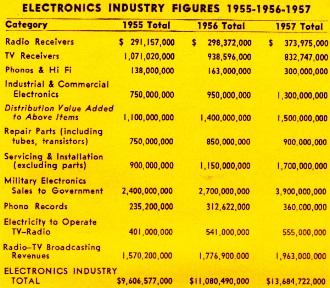|
August 1958 Radio-Electronics
 [Table of Contents] [Table of Contents]
Wax nostalgic about and learn from the history of early electronics.
See articles from Radio-Electronics,
published 1930-1988. All copyrights hereby acknowledged.
|
Today's consumer electronics
(CE) industry has an estimated value of around $980B per a
Statista report, with projections going to $1,160B in 2028. In
1957, according to this article in Radio-Electronics magazine, the market
value was reported to be $13.7B ($143B in 2023 dollars per the
BLS inflation calculator). The world population in 1957 was 2.89B
and has grown to 7.97B by 2023 (per Census.gov). That means population increased by a factor of 2.45
while the CE industry grew by a factor of 3.05. Within the margin of error of marketing
expert estimates, that represents essentially flat growth. Fret not, though, because
while the total spending on consumer electronics per capita might have been flat
over a span of nearly 60 years, the effective cost per electronics product and the
vastly improved functionality and reliability of electronics products has increased
by a much larger factor (I won't even venture a guess at a number). There is also
a much greater worldwide participation in the CE market now, which makes even a
flat growth in constant dollars an better deal.
This analysis illustrates how the same statistics can be used to support either
side of an argument. I could have easily taken a pessimistic view and lamented at
how the consumer electronics market has not grown in spite of all the research and
product development invested. Whenever I see a report that at first glance looks
dubious, I always look for the information behind the data. Often, there is a flagrant
agenda in play meant to increase the financial and/or political fortunes of a select
group. Take, for example, AGW.
Our Growing Industry... Radio-Electronics Leaps into the Space
Age

Hugo Gernsback, Editor
Seven years ago, in our November, 1951, editorial "Radio-Electronic Giant," we
made the then-considered-rash forecast that by 1960 the radio-electronic industry
would reach a fabulous $10 billion. That figure was based on a total dollar volume
exclusive of military electronics.
This highly optimistic forecast proved to be very tame and far too conservative.
Long before 1960, in 1957, to be exact, the industry, in-creasing by leaps and bounds,
had grown to a healthy total of $9.78 billion, exclusive of mili-tary electronics
- and still had three years to go!
If we add the military orders to this, we come to the astonishing total of close
to $13.7 billion in 1957.
There are those who feel that the industry will experience a severe setback in
1958. We do not share this pessimistic view. Indeed, a compilation of authoritative
figures, made at the time this was written (late in May) indicates that the total
effective recession the first quarter of 1958 for the industry was not more than
5% to 8%. This comparatively small decline may be wiped out entirely by the end
of 1958, and it is quite possible that 1958 may exceed the 1957 total.
Let us review here only the last three years to obtain a better perspective of
our industry. All figures are factory values, except phono records, which are retail
(see table).
How does the immediate future appear from these figures - let us say up to the
end of 1960? We have projected here a forecast which, in view of the past record
of the industry, seems conservative. We feel certain that our figures again, as
in the past, will prove low. Why: There are a number of excellent reasons why the
industry MUST move forward, if we leave out of this forecast such imponderables
as a world war.
 Natural growth. Even without
the factors listed below, the industry must speed up due to its own growth momentum. Natural growth. Even without
the factors listed below, the industry must speed up due to its own growth momentum.
Population growth. At present, the total US population is 173.8
million. By the end of 1960, we will number 180 million. More people mean an increased
demand for everything - electronics included.
New Inventions and Discoveries. If you look back only 10 years
you will find that there were thousands of now familiar radio-electronic items not
then in existence, from transistors to sputniks. Now, under the healthy and salutary
pressure of Russian competition, we are really flexing our muscles and moving fast.
The next three years will tell the story.
Space electronics. No branch of the industry is moving faster
than missiles, rockets and space vehicles. Electronics is the key to all of them.
Here it is that radio-electronics really will dazzle the past. And when it comes
to the highly sophisticated electronic instrumentation of the future, we really
have not scratched the surface. Great breakthroughs are on the horizon, pointing
to planet-wide radar, foolproof missile and space-vehicle guidance, collision proof
aircraft and automobiles, positive electronic missile interceptors, and a host of
others.
All in all, there seems to be no limit in sight to future electronic
expansion. - H. G.
Posted May 5, 2023
(updated from original post
on 6/26/2014)
|










